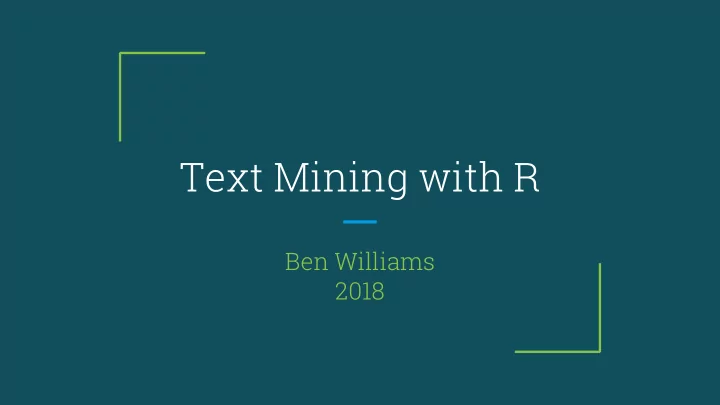

Text Mining with R Ben Williams 2018
Resources Text Mining with R: Julia Silge (StackOverflow) & David Robinson (DataCamp) https://www.tidytextmining.com/ R for Data Science: Garrett Grolemund & Hadley Wickham http://r4ds.had.co.nz/ Both are free!
Tidy Data In general: -> 1 observation per row, 1 variable per column Text Mining: -> One token per row Token: word, bigram, n-gram, etc .
Tools for Tidying Data tidyverse packages: dplyr, ggplot2, tidyr, stringr, readr (the package tidyverse contains many of the useful packages and loads them all at once) group_by()/ungroup(): group by a variable, then perform groupwise operations filter() : filter rows select(): select columns count(): count the number of observations in a group mutate(): add a new column %>% : “composed of”, “then”
Brief Aside if Necessary %>% is called a pipe (see R for Data Science 5.6 for more info) The %>% lets us easily and clearly combine functions in R x %>% f(y) really means, f(x,y). Example: data_stat_club is dataset of everyone’s name, age, birthplace data_stat_club %>% select(age) %>% mean(na.rm=T) #this takes the tibble data_stat_club, selects the variable age , and gets its mean
Data Can read .csv, .tsv, .xlsx, etc. into R. Look up readr and readxl package for more info. i.e. read_csv() We want data formatted as a data frame or as a tibble (a data frame that prints to the console nicely) Want: Text in one column of the tibble, does not have to be one token-per-row to be read into R
Tidy Text Data Package: tidytext Function: unnest_tokens(tbl,output,input,token=”words”) unnest_tokens() takes your data (tibble or data frame) and a given character column and tokenizes that column. By default, it splits the column into words This is the first step in tidying the data. See first part of R Code
Stop Words Stop Words are words we assume are uninformative in any sort of textual analysis, such as “the”, “and”, “is”, “were”, etc. tidytext has provided a tibble of stop words called stop_words . The columns are “word” and “lexicon” We can remove stop words from our newly tidy text data using anti_join() text_data %>% #unclean data is text_data unnest_tokens(text,word) %>% #input column is “text”, output is “word” anti_join(stop_words) #remove any stop words
Sentiment Analysis Idea: sometimes a word has an emotion or sentiment associated with it. We can analyze the text based on these emotions For example: “joyful” might be classified as positive, and “distraught” might be classified as negative Somewhat ad hoc in my mind: i.e. “not happy” -> “happy” without stop words -> classified as positive. There had been work done on negating words though... Lexicons built into tidytext package, can also specialize it for your own text
Topic Modeling Latent Dirichlet Allocation (LDA) Topic Modeling is an unsupervised algorithm that “groups” a corpus into a given number of topics. In LDA each document is represented by a distribution of topics which are characterized by a distribution over the unique words in the corpus (Blei, Ng and Jordan, 2003) Think of Dallas Morning News, say we model it with 4 topics. 1: (president, mayor, vote, county, judge, senate,...) 2: (golf, hockey, Dirk, cowboys, basketball, soccer, …) 3: (sunny, rain, sun, wind, cold, flood, temperature, high,...) 4: (police, crime, prison, bail, officer, shooting, robbery,...) Each newspaper article is made up of these topics, each topic is a distribution over all the unique words in the corpus of newspapers
Document Term Matrix (DTM) Matrix where rows are documents of a corpus, and columns are terms in vocabulary A DTM is the input into an LDA model, along with the parameter for number of topics Transform tidy data to DTM: cast_dtm(data,document,term,count) Tidy a DTM: tidy(dtm)
Beta and Gamma Beta: per-topic-per-word probability -Use to see what words are important in each topic Gamma: per-document-per-topic probability -Use to see what topics make up each document
Shiny Tool - if time https://github.com/williamsbenjamin/nesting-topics app_comp.R and app_hand.R are Shiny scripts that make a Sunburst of hierarchically nested topic models. They use two datasets available on my github. Check out the datasets to see the format for creating a Sunburst. Really easy and a great interactive tool! Sunburst is a D3 visualization that has been transferred to an R package as well.
Questions? benjamin@smu.edu
Recommend
More recommend